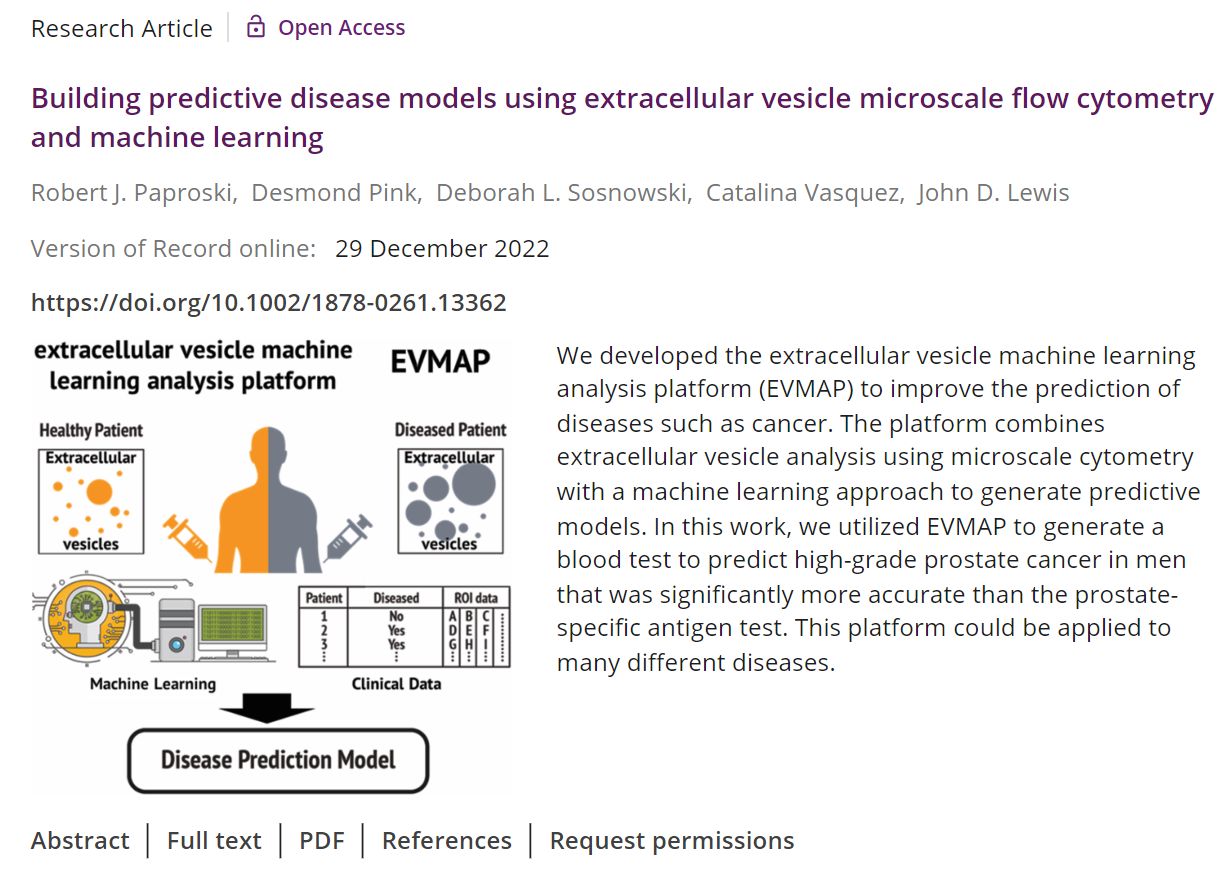Research supporting ClarityDX Prostate published in Nature Digital Medicine
Development of an effective predictive screening tool for prostate cancer using the ClarityDX machine learning platform
M. Eric Hyndman, Robert J. Paproski, Adam Kinnaird, Adrian Fairey, Leonard Marks, Christian P. Pavlovich, Sean A. Fletcher, Roman Zachoval, Vanda Adamcova, Jiri Stejskal, Armen Aprikian, Christopher J. D. Wallis, Desmond Pink, Catalina Vasquez, Perrin H. Beatty & John D. Lewis
EV-Fingerprint test predicts aggressive prostate cancer
Clinical analysis of EV- Fingerprint to predict grade group 3 and above prostate cancer and avoid prostate biopsy
Adrian Fairey, Robert J. Paproski, Desmond Pink, Deborah L. Sosnowski, Catalina Vasquez, Bryan Donnelly, Eric Hyndman, Armen Aprikian, Adam Kinnaird, Perrin H. Beatty, John D. Lewis
Cytometry Part A: Antibody titrations are critical for microflow cytometric analysis of extracellular vesicles
Molecular Oncology: Building predictive disease models using extracellular vesicle microscale flow cytometry and machine learning
We developed the extracellular vesicle machine learning analysis platform (EVMAP) to improve the prediction of diseases such as cancer. The platform combines extracellular vesicle analysis using microscale cytometry with a machine learning approach to generate predictive models. In this work, we utilized EVMAP to generate a blood test to predict high-grade prostate cancer in men that was significantly more accurate than the prostate-specific antigen test. This platform could be applied to many different diseases.
BMJ Open Cohort Profile Article: the Alberta Prostate Cancer Research Initiative (APCaRI) Registry and Biorepository facilitates technology translation to the clinic through the use of linked, longitudinal clinical and patient-reported data and biospecimens from men in Alberta, Canada
The APCaRI Registry and Biorepository, established in 2014, facilitates the collection of clinical and patient-reported data plus biospecimens, to measure prostate cancer outcomes and support the development and clinical translation of innovative technologies. The ultimate goal is to better diagnose and predict outcomes for patients with prostate cancer.
AUTHOR: CATALINA VASQUEZ, MICHAEL KOLINSKY, RUME DJEBAH, MAXWELL UHLICH, BRYAN DONNELLY, ADRIAN S FAIREY, ERIC HYNDMAN, NAWAID USMANI, JACKSON WU, PETER VENNER, DEAN RUETHER, GERALD TODD, MICHAEL CHETNER, R TRAFFORD CRUMP, PERRIN H BEATTY, JOHN D LEWIS
Cowpea mosaic virus nanoparticles for cancer imaging and therapy
Nanoparticle platforms are attractive for theranostic applications due to their multifunctionality and multivalency. Some of the most promising nano-scale scaffolds have been co-opted from nature, such as the cowpea mosaic virus (CPMV). What makes CPMV so promising? They are non-infectious and nontoxic to humans and safe for use in intravital imaging and drug delivery. Click on the link to read more.
AUTHOR: PERRIN BEATTY AND JOHN LEWIS
PROSPeCT: A Predictive Research Online System for Prostate Cancer Tasks
We are pleased to present PROSPeCT, a user-friendly online clinical information system that offers an efficient way to query APCaRIs (www.APCaRI.ca) robust and expanding patient database to generate relevant and accurate results. Read the details in our article published in the Journal of Clinical Oncology – Clinical Cancer Informatics. Thank you to the Alberta Cancer Foundation and many others for their support.
AUTHOR: AUTHOR: MARIA CUTUMISU, CATALINA VASQUEZ, MAXWELL UHLICH, PERRIN H. BEATTY, HOMEIRA HAMAYELI-MEHRABANI, RUME DJEBAH, ALBERT MURTHA, RUSSELL GREINER, AND JOHN D. LEWIS
Intravital imaging tumor screen used to identify novel metastasis-blocking therapeutic targets
This is a micro-review of an original research article from the Lewis research group that identified multiple novel metastasis-blocking targets, by using a whole genome screen and intravital imaging approach, that could be used as therapeutic targets to inhibit solid tumour cell motility.



